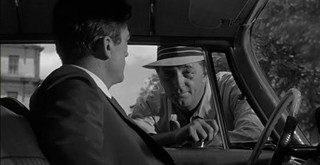In the movie world, there are actors who play badasses. Then there are actors who are badasses.
Take Robert De Niro, for example: A very talented Method actor who made a career of transforming himself onscreen into a very convincing badass, when in reality he’s bookish and shy by most accounts.
Well, back in the day there was an actor named Robert Mitchum, who was the Bizarro World De Niro: A straight–up badass who happened to do some acting on the side.
Like Marlon Brando — another of those alpha males from the Golden Age of Cinema who seemingly bullied his way onto stage and screen almost by sheer physical force — Bob Mitchum would often tell people how ridiculous he felt acting, and what a colossal joke show business really is. (But that never stopped either from cashing their paychecks...)
For those of you familiar with De Niro’s turn as the villainous Max Cady in the 1991 film Cape Fear, get ready for the real thing this Saturday, with Bob Mitchum in the role instead.
As part of the SCAD Cinema Circle series, the Trustees is screening the original Cape Fear, shot in 1961 in and around Savannah.
It’s the story of ex–con Cady’s terrorization of the family of lawyer Sam Bowden (Gregory Peck), who once sent him to jail. And it’s terrifying.
My family has always had a special place in our hearts for the original Cape Fear because my father has a line of dialogue in the movie. Dad played the driver who accidentally hits young Nancy when she runs out into the street (actually Bull Street just south of Forsyth Park, in front of the Bouhan Williams and Levy building).
His line, delivered in that staccato, theatrical style typical of the time: “She ran right out in front of me.”
Good job, Dad. We’ll look for you again!
Anyway, back to Bob Mitchum: Savannah in those days was a far cry from what it is today. Downtown had begun sliding into the white–flight irrelevance from which it only fully emerged in the 1990s. In the early ‘60s it was little more than a charming but forgotten Southern backwater with a history of sketchy seaport hijinks.
By the time he was cast in Cape Fear, Mitchum was already no stranger to Savannah. During one of his frequent delinquent phases as a young man, he was actually busted for vagrancy here and sentenced to serve on a chain gang, from which he promptly escaped. (Mitchum’s character is actually confronted by cops for vagrancy in the film.)
Legend has it that Mitchum retained a visceral distaste for Savannah, and supposedly demanded that some scenes — including the final confrontation in the “swamp” (actually a lake in California) between him and Gregory Peck’s character — be shot elsewhere.
You’ll recognize several other parts of town in the movie.
Mitchum didn’t leave his scofflaw nature on the side of the road with that chain gang. During the filming of Cape Fear, he was on probation for marijuana possession.
In addition, he brought a genuine, inborn level of menace to the set which was palpable.
Director J. Lee Thompson recalled: “...when we had the violent scenes, he did work himself up. When he was playing one of those scenes he looked at you like he was going to kill you.”
Several times Thompson had to stop filming to let everyone cool down. That final Mitchum vs. Peck battle in the water is all the more gripping given the actual level of violence involved; there was a consensus that Mitchum would hold Peck underwater a little too long during filming of the fight sequence.
In some shots Peck — no stranger to bravery himself — is literally fighting for his life, on camera.
“We devised a code so that Peck could come up if it was getting too much for him,” recalls director Thompson. “But sometimes Mitchum overstepped the line. I mean, he was meant to be drowning Greg, and he really took it to the limit.”
The visceral impact of this movie, and the real sense of terror it evokes any second that Mitchum’s character is onscreen, is all the more remarkable given the time in which it was shot. Films then were not only much less graphic than today, even allusions to objectionable off–screen acts were censored.
The Production Code Administration — the entity charged with enforcing movie censorship during the Cold War era — said that Cape Fear should remove “all shots which concentrate on the middle part of the pursuer’s body.” Two lines were to be cut: “Nancy is getting to be almost as juicy as your wife,” and “I kept her busy for three days.”
All of which, of course, are standard prime–time fare on the lamest of broadcast shows today.
In addition, a shot of Mitchum’s character kneeing a man in the groin was to be removed — an act which 20 years later would spawn an entire genre of home video TV shows.
Yet the original Cape Fear’s barely contained sense of suffocating, dire, imminent threat remains to this day as powerful as ever — no matter how many times it might be remade.
Cape Fear (1962)
When: Saturday, July 14, 7 p.m.
Where: Trustees Theatre, 216 E. Broughton St.
Cost: $8
Info: scad.edu




























